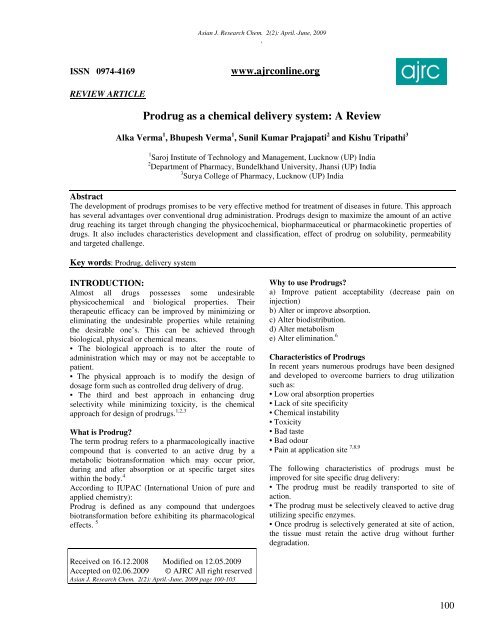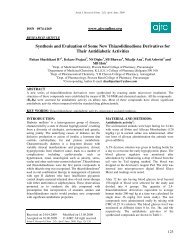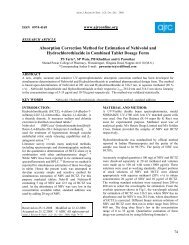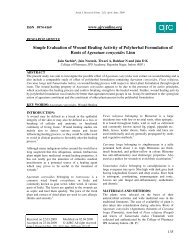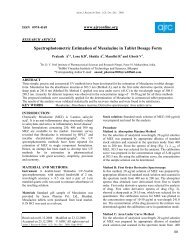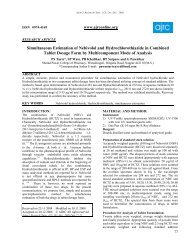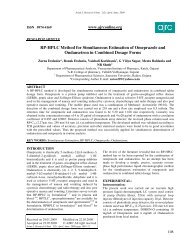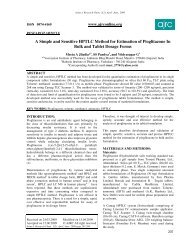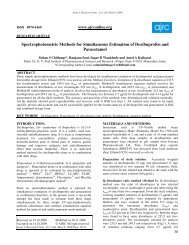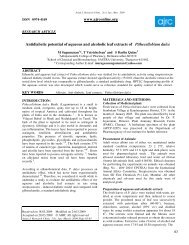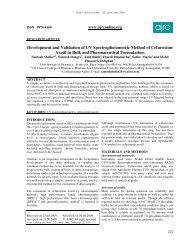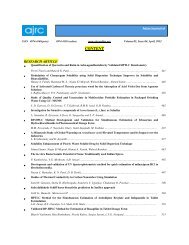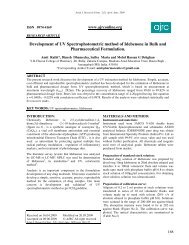Prodrug as a chemical delivery system - Asian Journal of Research ...
Prodrug as a chemical delivery system - Asian Journal of Research ...
Prodrug as a chemical delivery system - Asian Journal of Research ...
Create successful ePaper yourself
Turn your PDF publications into a flip-book with our unique Google optimized e-Paper software.
<strong>Asian</strong> J. <strong>Research</strong> Chem. 2(2): April.-June, 2009<br />
,<br />
ISSN 0974-4169<br />
www.ajrconline.org<br />
REVIEW ARTICLE<br />
<strong>Prodrug</strong> <strong>as</strong> a <strong>chemical</strong> <strong>delivery</strong> <strong>system</strong>: A Review<br />
Alka Verma 1 , Bhupesh Verma 1 , Sunil Kumar Prajapati 2 and Kishu Tripathi 3<br />
1 Saroj Institute <strong>of</strong> Technology and Management, Lucknow (UP) India<br />
2 Department <strong>of</strong> Pharmacy, Bundelkhand University, Jhansi (UP) India<br />
3 Surya College <strong>of</strong> Pharmacy, Lucknow (UP) India<br />
Abstract<br />
The development <strong>of</strong> prodrugs promises to be very effective method for treatment <strong>of</strong> dise<strong>as</strong>es in future. This approach<br />
h<strong>as</strong> several advantages over conventional drug administration. <strong>Prodrug</strong>s design to maximize the amount <strong>of</strong> an active<br />
drug reaching its target through changing the physico<strong>chemical</strong>, biopharmaceutical or pharmacokinetic properties <strong>of</strong><br />
drugs. It also includes characteristics development and cl<strong>as</strong>sification, effect <strong>of</strong> prodrug on solubility, permeability<br />
and targeted challenge.<br />
Key words: <strong>Prodrug</strong>, <strong>delivery</strong> <strong>system</strong><br />
INTRODUCTION:<br />
Almost all drugs possesses some undesirable<br />
physico<strong>chemical</strong> and biological properties. Their<br />
therapeutic efficacy can be improved by minimizing or<br />
eliminating the undesirable properties while retaining<br />
the desirable one’s. This can be achieved through<br />
biological, physical or <strong>chemical</strong> means.<br />
• The biological approach is to alter the route <strong>of</strong><br />
administration which may or may not be acceptable to<br />
patient.<br />
• The physical approach is to modify the design <strong>of</strong><br />
dosage form such <strong>as</strong> controlled drug <strong>delivery</strong> <strong>of</strong> drug.<br />
• The third and best approach in enhancing drug<br />
selectivity while minimizing toxicity, is the <strong>chemical</strong><br />
approach for design <strong>of</strong> prodrugs. 1,2,3<br />
What is <strong>Prodrug</strong>?<br />
The term prodrug refers to a pharmacologically inactive<br />
compound that is converted to an active drug by a<br />
metabolic biotransformation which may occur prior,<br />
during and after absorption or at specific target sites<br />
within the body. 4<br />
According to IUPAC (International Union <strong>of</strong> pure and<br />
applied chemistry):<br />
<strong>Prodrug</strong> is defined <strong>as</strong> any compound that undergoes<br />
biotransformation before exhibiting its pharmacological<br />
effects. 5<br />
Why to use <strong>Prodrug</strong>s?<br />
a) Improve patient acceptability (decre<strong>as</strong>e pain on<br />
injection)<br />
b) Alter or improve absorption.<br />
c) Alter biodistribution.<br />
d) Alter metabolism<br />
e) Alter elimination. 6<br />
Characteristics <strong>of</strong> <strong>Prodrug</strong>s<br />
In recent years numerous prodrugs have been designed<br />
and developed to overcome barriers to drug utilization<br />
such <strong>as</strong>:<br />
• Low oral absorption properties<br />
• Lack <strong>of</strong> site specificity<br />
• Chemical instability<br />
• Toxicity<br />
• Bad t<strong>as</strong>te<br />
• Bad odour<br />
• Pain at application site 7,8,9<br />
The following characteristics <strong>of</strong> prodrugs must be<br />
improved for site specific drug <strong>delivery</strong>:<br />
• The prodrug must be readily transported to site <strong>of</strong><br />
action.<br />
• The prodrug must be selectively cleaved to active drug<br />
utilizing specific enzymes.<br />
• Once prodrug is selectively generated at site <strong>of</strong> action,<br />
the tissue must retain the active drug without further<br />
degradation.<br />
Received on 16.12.2008 Modified on 12.05.2009<br />
Accepted on 02.06.2009 © AJRC All right reserved<br />
<strong>Asian</strong> J. <strong>Research</strong> Chem. 2(2): April.-June, 2009 page 100-103<br />
100
Cl<strong>as</strong>sification <strong>of</strong> <strong>Prodrug</strong>s<br />
A) Carrier linked prodrug:<br />
• Contain a group that can be e<strong>as</strong>ily removed<br />
enzymatically (such <strong>as</strong> ester) to reveal the true drugs.<br />
• Ideally the group removed is pharmacologically<br />
inactive and nontoxic while the connecting bond must be<br />
labile for efficient activation in vivo.<br />
<strong>Prodrug</strong>s are the ones where the active drug is covalently<br />
linked to an inert carrier transport moiety. They are<br />
generally esters or amides. Such prodrugs have greatly<br />
modified lipophilicity due to the attached carrier and the<br />
active drug is rele<strong>as</strong>ed by hydrolytic cleavage, either<br />
<strong>chemical</strong>ly or enzymically. It can be further subdivided<br />
into-<br />
Bipartate- Composed <strong>of</strong> one carrier (group) attached to<br />
the drugs.<br />
Tripartat- Carrier group is attached via linker to drug.<br />
Mutual <strong>Prodrug</strong>s- Two drugs linked together.<br />
B) Bioprecursors:<br />
Metabolized into a new compound that may itself be<br />
active or further metabolized to an active metabolite<br />
(e.g. amine to aldehyde to carboxylic acid) 10.<br />
Site specificity:<br />
The most important feature <strong>of</strong> efficient drug is right site<br />
<strong>of</strong> action. It is necessary to deliver the drug precisely to<br />
the affected part <strong>of</strong> body, where it is supposed to be<br />
attacked.<br />
• At le<strong>as</strong>t three following factors should be optimized to<br />
obtain a prodrug acting at specific site:<br />
1)<strong>Prodrug</strong> must be directly transported to the site <strong>of</strong><br />
action, and uptake at the site must be rapid and<br />
essentially perfusion rate must be limited.<br />
2) Once the prodrug reaches the site <strong>of</strong> its action, it must<br />
be selectively cleaved yielding the active drug, relative<br />
to its conversion at other sites.<br />
3) Once selectively generated at site <strong>of</strong> action, the active<br />
drug must be retained by tissue. 11<br />
Solution-<br />
These problems can be overcome by:<br />
• Targeting the drug to its site <strong>of</strong> action by altering its<br />
disposition characteristic.<br />
• There are several approaches to drug targeting and<br />
prodrug design is one <strong>of</strong> them. 12<br />
For site specificity:<br />
1. Selective uptake <strong>system</strong><br />
Dopamine,a neurotransmitter, produce V<strong>as</strong>odilation <strong>of</strong><br />
renal tissue by binding to specific receptor in kidney and<br />
this can be used to treat renal hypertension. However,<br />
the therapeutic index <strong>of</strong> dopamine is small <strong>as</strong> it<br />
precipitates high blood pressure by interaction with -<br />
adrenergic receptor. This can be overcome by taking<br />
<strong>Asian</strong> J. <strong>Research</strong> Chem. 2(2): April.-June, 2009<br />
,<br />
advantage <strong>of</strong> fact that -gultamyl derivatives <strong>of</strong> amino<br />
acid and peptides selectively accumulates in kidney.<br />
Such a derivative <strong>of</strong> dopamine, on reaching the kidney it<br />
is acted upon successively by two enzymes that are<br />
present in high concentration in renal tissue, - glutamyl<br />
transpeptid<strong>as</strong>e and L-aromatic amino acid decarboxyl<strong>as</strong>e<br />
to rele<strong>as</strong>e the active drug dopamine locally. This<br />
incre<strong>as</strong>e in dopamine levels produces a marked incre<strong>as</strong>e<br />
in renal blood flow.Same principle can be used to<br />
deliver sulfonamides selectively to kidneys, the prodrug<br />
used are M-acyl- -glutamyl Sulfonamides. 13,14,15,16<br />
(2) For Urinary tract infection:<br />
Hexamine is a stable inactive compound at pH greater<br />
than 5. However, in mere acidic pH, the compound<br />
disintegrate spontaneously to form formaldehyde, which<br />
h<strong>as</strong> antibacterial properties.This is useful for treatment<br />
<strong>of</strong> urinary tract infections. The normal pH <strong>of</strong> blood is<br />
slightly alkaline and so the drug circulate in the body <strong>as</strong><br />
unchanged. However,once it is excreted into urinary<br />
tract, it encounters urine, which is acidic <strong>as</strong> a result <strong>of</strong><br />
bacterial infection. 17<br />
(3) Anticancer chemotherapeutic agent:<br />
These are cytotoxic because they attack growing normal<br />
cells. An example <strong>of</strong> site specific prodrug is diethyl<br />
stilbestrol diphosphate, which is designed for treatment<br />
<strong>of</strong> bre<strong>as</strong>t cancer.<br />
The site specific <strong>delivery</strong> can be obtained by tissue<br />
specific activation <strong>of</strong> the prodrug which results <strong>of</strong><br />
metabolism by an enzyme that is either unique for tissue<br />
or present at higher concentration if we compare with<br />
other tissues.<br />
The example <strong>of</strong> prodrug, whose design is b<strong>as</strong>ed on site<br />
specific conditions such <strong>as</strong> lack <strong>of</strong> oxygen in cells i.e<br />
hypoxic cells,is trapazamine (TPZ) is a bioreductive<br />
drug that exhibits greatly enhanced cytotoxicity in<br />
hypoxic cells, which are frequently radiation resistant<br />
and chemoresistant.<br />
TPZ exhibits particularly good activity when combined<br />
with alkylating agent such <strong>as</strong> cyclophosphamide (CPA)<br />
These findings suggests the potential benefit <strong>of</strong><br />
incorporating TPZ, and perhaps, other bioreductive<br />
drugs into a P450/P480 reduct<strong>as</strong>e b<strong>as</strong>ed gene therapy<br />
strategy for cancer treatment 18 ..<br />
Stability and Resistance<br />
The drug must be resistant to degradation in different<br />
body parts and fluids. L-DOPA is the most important<br />
prodrug that is used in treatment <strong>of</strong> Parkinson’s dise<strong>as</strong>es.<br />
It is the biological precursor <strong>of</strong> Dopamine and may be<br />
considered, to be a prodrug. The incre<strong>as</strong>ed oral<br />
bioavailability <strong>of</strong> catecholamine, while retaining the<br />
catecholamine itself <strong>as</strong> an active component, is achieved<br />
by protection <strong>of</strong> hydroxyl and amino groups. The<br />
101
protecting groups are designed to be less susceptible to<br />
metabolism and to gradual dissociation from the<br />
catecholamine molecule in-vivo. There are also other<br />
prodrugs <strong>of</strong> Dopamine and <strong>of</strong> analogues <strong>of</strong><br />
catecholamine, designed to cross the blood brain barriers<br />
(BBB) and to centrally undergo slow hydrolysis to give<br />
the active species. The hydroxyl groups on the catechol<br />
ring are usually protected by formation <strong>of</strong> di-o-pivaloyl<br />
or di-o-benzoyl esters.<br />
The antibacterial agent ampicillin is decomposed<br />
because <strong>of</strong> the intermolecular attack <strong>of</strong> side chain amino<br />
group on the lactam ring. The prodrugs Hetacillin lock<br />
up the <strong>of</strong>fending amino group in -ring and prevents<br />
decomposition reaction by bacterial -lactam<strong>as</strong>es. Once<br />
the drug h<strong>as</strong> been administered, the drug undergoes<br />
hydrolysis on its own to rele<strong>as</strong>e ampicillin and acetone. 19<br />
<strong>Prodrug</strong> may protect a drug from first p<strong>as</strong>s effects,<br />
propranolol , -blocker and antihypertensive drug, which<br />
suffers, from the first p<strong>as</strong>s elimination resulting in<br />
decre<strong>as</strong>ed bioavalibility <strong>of</strong> oral doses compared to<br />
intravenous injections. One <strong>of</strong> the major metabolites is<br />
the o-glucuronide. The hemisuccinate ester w<strong>as</strong> designed<br />
to block glucuronide formulation resulting in 8-fold<br />
incre<strong>as</strong>e in pl<strong>as</strong>ma levels <strong>of</strong> propanolol. 20<br />
Naltrexone (NTX) ,opioid antagonist,used for treatment<br />
<strong>of</strong> narcotic dependence and alcoholism. Transdermal<br />
NTX <strong>delivery</strong> is desirable to help to improve patient<br />
compliance in order to incre<strong>as</strong>e the <strong>delivery</strong> rate <strong>of</strong> NTX<br />
across human skin. 21<br />
Toxicity<br />
Derivative <strong>of</strong> salicylic acids are one <strong>of</strong> the oldest<br />
example that are characterized by lesser toxicity than<br />
their parent drugs. Salicylic acid is a good pain-killer but<br />
causes g<strong>as</strong>tric irritation and bleeding because <strong>of</strong><br />
carboxyl group. It accumulates in the g<strong>as</strong>tric mucosal<br />
cells. Aspirin, esters <strong>of</strong> salicylic acid,suppresses g<strong>as</strong>tric<br />
irritation. 22<br />
<strong>Prodrug</strong>s can be used to afford drugs that would be too<br />
toxic to be given directly, a feature <strong>of</strong> the slow rele<strong>as</strong>e.<br />
Propanaldehyde is useful for aversion therapy in patients<br />
addicted to alcohol. However, it is a highly irritating<br />
<strong>chemical</strong> and causes allergic reactions. As an alternative,<br />
a closely related compound, pargyline is used.<br />
<strong>Asian</strong> J. <strong>Research</strong> Chem. 2(2): April.-June, 2009<br />
,<br />
using palmitate ester, which is quickly hydrolyzed once<br />
swallowed. 24<br />
Mutual <strong>Prodrug</strong>- A therapeutically significant drug may<br />
have limited utilization in clinical practice because <strong>of</strong><br />
poor organoleptic properties, poor bioavailability etc.<br />
Mutual prodrug is a type <strong>of</strong> carrier linked prodrug,<br />
where carrier used in is another biologically active drug<br />
instead <strong>of</strong> some inert molecule. A mutual prodrug<br />
consist <strong>of</strong> two pharmacologically active agents coupled<br />
together so that each act <strong>as</strong> a promoiety for the other<br />
agent and vice versa.<br />
Mutual prodrug design is really do not differ from<br />
general drug discovery process in which a unique<br />
substance is observed to have desirable pharmacological<br />
effects, and studies <strong>of</strong> its properties lead to the design <strong>of</strong><br />
better drugs. 25<br />
CONCLUSION<br />
Site specificity is central to the prodrug development<br />
strategy. Even though at present prodrug are not<br />
prevalent in clinical use, in future there will be prodrugs<br />
for every known drug to make them effective in<br />
treatment drug discovery and prodrug development<br />
appear to be complementary for the generation <strong>of</strong> target<br />
specific medicines <strong>of</strong> future.<br />
At present the research in this area is at a n<strong>as</strong>cent stage<br />
due to lack <strong>of</strong> information, regarding all enzymes or<br />
receptors, most suitable for targeting purposes. As the<br />
unrevealing <strong>of</strong> the microbiological details <strong>of</strong> affected<br />
targets become clear, prodrug development will surely<br />
decre<strong>as</strong>e side/toxic effect <strong>of</strong> drugs and also trigger<br />
development <strong>of</strong> more potent primary drugs.<br />
<strong>Prodrug</strong>s are used to overcome several undesirable<br />
properties in order to achieve the best clinical drug<br />
application.<br />
The newest discoveries <strong>of</strong> molecular biology provide<br />
essential information about enzymes and carriers<br />
proteins. It is clear from the foregoing that design <strong>of</strong><br />
drug cannot be b<strong>as</strong>ed just on <strong>chemical</strong> synthesis. Drug<br />
discovery and prodrug and s<strong>of</strong>t drugs development<br />
appears to be complementary for generation <strong>of</strong> target<br />
specific medicine now and in the future.<br />
The prodrug that is converted to the active drug at the<br />
target site itself greatly reduced side effects <strong>of</strong> highly<br />
toxic drugs. 23<br />
Poor patient Acceptability<br />
Some drugs have a revolting t<strong>as</strong>te. One way to reduce<br />
this problem is to decre<strong>as</strong>e their solubility in water so<br />
that they do not dissolve on the tongue, for e.g the bitter<br />
t<strong>as</strong>te <strong>of</strong> antibiotic Chloramphenicol can be avoided by<br />
REFERENCE<br />
1. Robinson R.Joseph,Lee Vincent H.L., Controlled Drug<br />
Delivery fundamental and application , 2nd edition,337-<br />
369.<br />
2. http://www.ingentaconnet.com/content/maik/biry/2002/00<br />
0000067/00000010/0 0458028?crawler=true.<br />
3. Bahl C.R.,Primpl<strong>as</strong>kan H.K.,Sileno A.P.,Demeireles J.,<br />
and Remeo V.D. ,Vol 29,1-2, 5Jan,1998,89-116<br />
4. Tripathi K.D. Essentials <strong>of</strong> medical pharmacology.4th<br />
edition , 25.<br />
5. IUPAC Pure and appl. chem.,1998,70,1129-1143<br />
102
<strong>Asian</strong> J. <strong>Research</strong> Chem. 2(2): April.-June, 2009<br />
,<br />
6. http://uwacadweb.uwyo.edu/ONTKO/PHCY%206110/lec<br />
tures/299,2,non prodrug<br />
7. Mayer D.L., Jungheim L.N, Law K.L., Mikolajczyle S.D.,<br />
Shapherd T.A., Cancer Res.,1993, sep.1:53(17):3956-63.<br />
8. S.Kenneth, <strong>Prodrug</strong> topical and ocular drug <strong>delivery</strong>,17-<br />
22.<br />
9. www.Pharm-today.com/uploads/media/files/ prodrug-<br />
20080425-185<br />
10. http://userwww.sfsu.edu/~cberkman/640-notes-1.5pdf<br />
11. Friend D.R.,Chang G .W,J. Med chem.,1984,27,261-266<br />
12. Kawakami S.,Yamishita.F., H<strong>as</strong>hida M., Adv. Drug<br />
Delivery Review,Vol 45,Issue 1, 6 dec 2000,77-88.<br />
13. Fernandez C., Nieto <strong>of</strong>ilia, Fontenla J.A., Rav<strong>as</strong> E.L.,<br />
Maria, M.F., Alfonso;Org. Biomol. Chem. 2003,1,767-<br />
771.<br />
14. Silverman R.B.,The organic chemistry <strong>of</strong> drug design and<br />
drug action,2nd ed,544-547.<br />
15. Mustafa F., Lokhandwala B. J., Richard, Drug<br />
Dev.<strong>Research</strong>, vol 3, issue 4, 299-310.<br />
16. SteelaV.J. Borchardt R.T.,Hageman M.J.,Oliyai<br />
R.,M.Hans,Tilley J.W., <strong>Prodrug</strong> challenges and<br />
rewards,41-46.<br />
17. Long C H: urinary tract infection ,The blong kong<br />
practitioner,1978,1,1-6.<br />
18. Stanczak andraj ferra anna pharmacological report<br />
,2006,58,599-613<br />
19. Tsujia Y T,Pharm bull,1974,22,2434-2443.<br />
20. Chandr<strong>as</strong>etchar U, Giridha T,Ashima<br />
K.M,J.Pharm.Sci.2000,88,544-550.<br />
21. Stinchomb A.L.,Hammel D. C.,Challapalli,PVN,Paxton<br />
EW,Swan P W,Klauser M,J.Pharm Sci,2002,91,2571-<br />
2578.<br />
22. Surgya H.,Prak<strong>as</strong>h R :Capping drug :development <strong>of</strong><br />
prodrug –resonance 2003<br />
23. Schwartz PS,Chen C S, Waxman DJ, cancer drug<br />
therapy,2003,10,571-582.<br />
24. Zajac M. Pawelezy K E:chemistery <strong>of</strong> drug medical<br />
academy poranam 2000<br />
25. Bhosle D. ,Bharamba S.,Gairola N.,S.Suneela,<br />
Dhaneshwar,Indian J. <strong>of</strong> Pharma sciences,May-June<br />
2006, 286<br />
103


